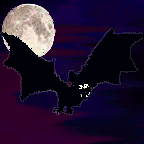
SIZES
LENGTH: Body, 2 3/4 in.
BREEDING
SEXUAL MATURITY: 9 mos.
LIFESTYLE
HABIT: Nocturnal. Lives in
DIET: Blood of domestic
LIFESPAN: 9 years in the
HOME
Central and South America, in
RELATED SPECIES
There are two other species
They are not currently on the
WINGSPAN: 8 in.
WEIGHT: 1 oz.
MATING SEASON: All Year
GESTATION: 6-8 mos.
# OF YOUNG: 1
colonies of 6 - 2,000, but
which usually no. 100.
animals, particularly cows,
pigs, and horses.
wild, 20 in captivity.
tropical and subtropical
regions from Mexico to
northern Chile and Argentina.
of true vampire bat: Diaemus
youngi and Diphylla ecaudata.
Endangered Species List.

For more information, go here:
http://www.batcon.org/
All the information on this
page was taken from the
WILDLIFE FACT FILE - Card 9

![]()
ORDER: Chiroptera
FAMILY: Desmodontidae
GENUS & SPECIES: Desmodus rotundus
![]()
Vampire bats are active only during the darkest periods of the night. It is the time when they are most likely to avoid being caught by such nocturnal preditors as owls. Also, the domestic animals on which the bats feed are often sleeping, and so are easier to approach undetected. During the day, vampire bats roost in colonies, hanging upside down in caves and hollow trees. They will sometimes move from one daytime roost to another which is closer to their prey. This kind of activity indicates that vampire bats learn from experience where their prey can be found. Vampire bats also use rivers as navigational tools as they move from one part of their range to another. The rivers are easier to follow than wooded routes, and cattle often graze in pastures near water.
The vampire bat feeds on the blood of animals. Cows, pigs, and horses are its favorite hosts. The bat will usually choose to feed on the most docile or isolated animal in the resting herd. Using its chisel-like incisor teeth, the bat makes a small cut in the animal's skin. It usually chooses a fleshy area, like the shoulder or neck, where the blood vessels are closer to the skin's surface. The bat then drinks (or rather laps) the blood that flows from the wound. Chemicals in the bat's saliva keep the blood flowing for the 2 - 3 minutes that the bat feeds. The bat's tongue has two lateral grooves which alternately open and close while the bat is feeding. This action draws the blood up the deeply grooved lower lip, channeling it into the mouth. An adult vampire bat will consume about five teaspoons of blood per day. Often two or three bats will feed from the same wound. In most instances, the host animal suffers no ill effects from the loss of blood, although if too many bats feed on the same animal, it may be severely weakened.
The vampire's ability to reproduce is limited by its need to remain light enough to fly. It gives birth to a single offspring after an unusually long gestation period of six to eight months. Born blind, the young bat is carried by its mother for the first few days of its life. Its eyes open after a week, and it takes its first flight when it is three weeks old. The young bat is sexually mature at nine months and breeds at any time of the year. Mating takes place while roosting upside down in the security of a cave.
The vampire bat can transmit rabies to livestock and man, although this is a rare occurance as less than 1% of vampire bats carries the disease. To control the vampire bats, cattle have been injected with anticoagulants, substances that do not harm the cows but will cause internal bleeding in the feeding bats. Anticoagulants have also been smeared on the bats themselves. When they return to their roost site, other bats in the colony groom them and ingest the fatal drug.



Hotel Vamphyri is proud to support the following:
![]()

![[Return to the Night Creature Index]](batbak.gif)
![[Return to Sacrosanctum]](bathome.gif)
![[Email Sacrosanctum]](batemail.gif)
![[OWLS!]](batnxt.gif)
![[Graphics by: Immortality, Inc.]](batby.gif)